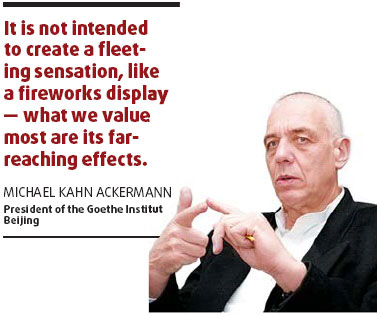Campaign aims at mass appeal
|
A model on display at last August's Nanjing leg of the 'Germany and China - Moving Ahead Together' initiative combined ancient Yangzhou architecture with hi-tech energy conservation. Wang Yuewu and Xu Liran |
After its launch last year in Nanjing, capital of east China's Jiangsu province, the ongoing "Germany and China - Moving Ahead Together" campaign now in Chongqing is once again sparking strong interest in things German.
From live performances by pop and rock bands to poetry readings and talk shows, the city's main public square has a thick German accent and atmosphere for the month-long gala.
Highlighting urban culture, the campaign will present a rounded perspective on German lifestyle and culture.
Among the 100 planned activities, more than 70 percent will involve joint participation, highlighting the concept of "moving together", according to Michael Kahn Ackermann, president of the Goethe Institut Beijing.
A performance by a German conductor and the local Chongqing symphony orchestra is an example, he added.
He also cited the return of Kreidekreis by renowned German playwright Bertolt Brecht to illustrate successful collaboration between the two sides.
The play based on an ancient Chinese story has been adapted to a Sichuan opera and will be performed by Chinese artists.
The successful cultural event helps foster mutual understanding and respect, Ackermann said.
The Goethe Institut - named for Johann Wolfgang von Goethe, a towering figure in European literature and philosophy - is funded by the German government to promote its language and culture abroad. The institute is coordinating the large, multi-year campaign.
Joint efforts
Yet the event underway in Chongqing is not limited to culture. It also showcases other facets of the nation, including its education, technology and economics.
"With globalization advancing, global issues like energy, the environment, cultural identity and information technology are becoming increasingly common challenges to us all - requiring cooperation between nations," Ackermann said.
President Hu Jintao and German President Horst Koehler are jointly serving as patrons of the event, reflecting the value both countries place on the concept, he noted.
As global challenges need responses from many fields, representatives from different walks are all encouraged to participate in the event, he said.
"It is not intended to create a fleeting sensation, like a fireworks display - what we value most are its far-reaching effects," said Ackermann.
"We have chosen 'sustainable urbanization', a challenging issue China has to face during its rapid growth, as the theme of the campaign," he says.
One illustration is the host city Chongqing itself that has an annual increase of 500,000 in its urban population.
How to accommodate new migrants in housing, education and employment while protecting the environment are major challenges authorities face.
Germany would like to share its own urbanization experience with China, said Ackermann.
Forums on sustainable city development and efficient use of energy will be held as part of the event.
Scholars and experts from both countries are expected to deepen their dialog and offer suggestions to planners.
Mass participation

In addition to experts, ordinary people's understanding and involvement are equally important, Ackermann said.
The three-year campaign is the biggest Germany has held to promote its national image abroad and is targeted at a mass audience.
It will cover different regions of China, including fast-growing second-tier cities like Nanjing in the east, Chongqing in the southwest and Guangzhou in the south.
Two other host cities, likely in central and northeast China, will be announced in the next four months, according to organizers.
To promote awareness of environmental protection, organizers have set up exhibition halls made of bamboo.
Many visitors were first confused why Germany, known for its hi-tech edge, uses such humble building material, Ackermann recalled.
Some German firms were even reluctant to present themselves in pavilions made of bamboo, he added with a grin.
"Yet they finally found it a great idea. In this way we have demonstrated that the reproducible material, which has ample supply in China, has incredible opportunities and great market prospects," he stressed.
Bamboo pavilion designer Bauen mit Bambus has now been invited to two Chinese universities to give lectures after its structures debuted in Nanjing.
(China Daily 05/09/2008 page18)















